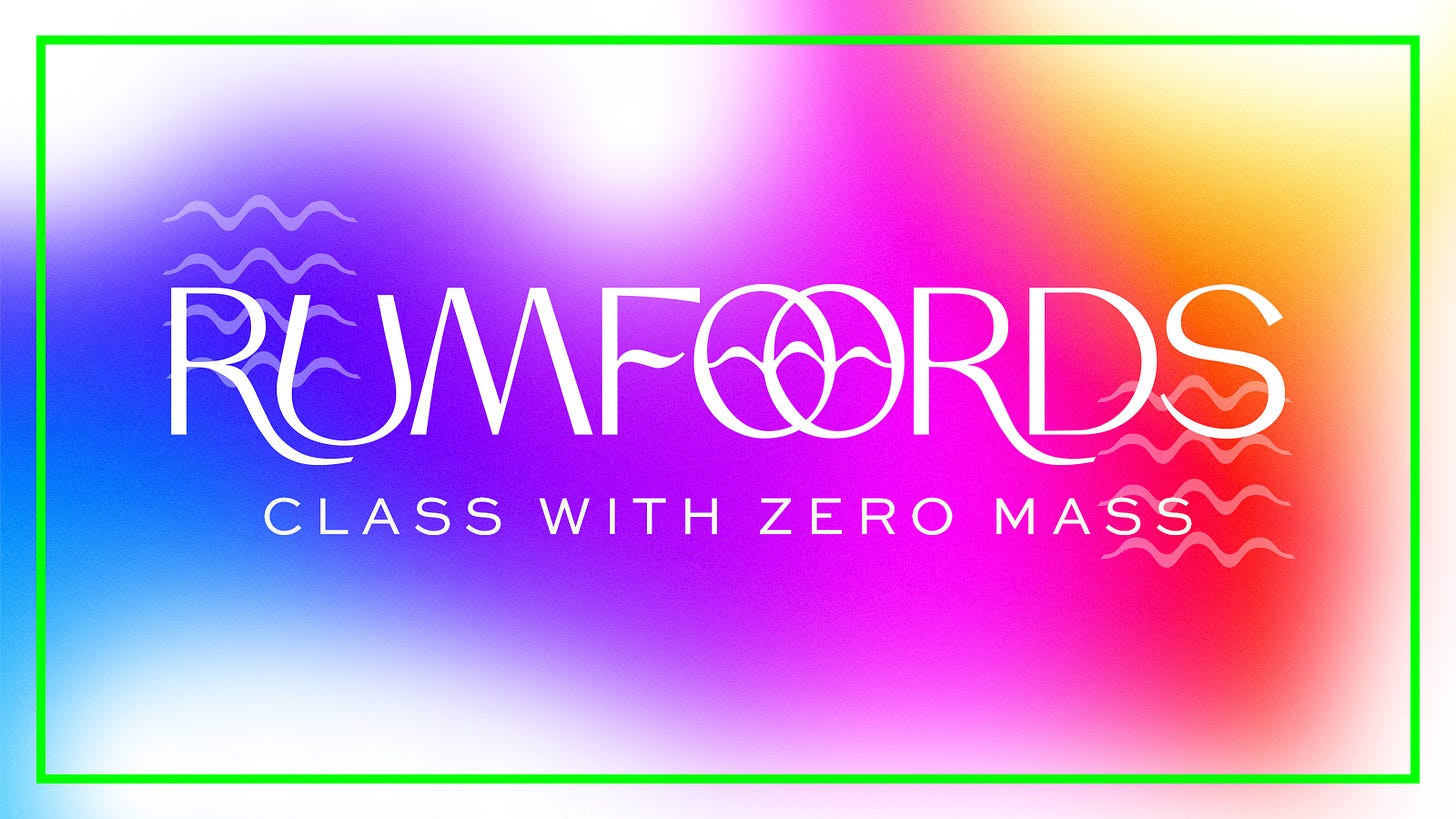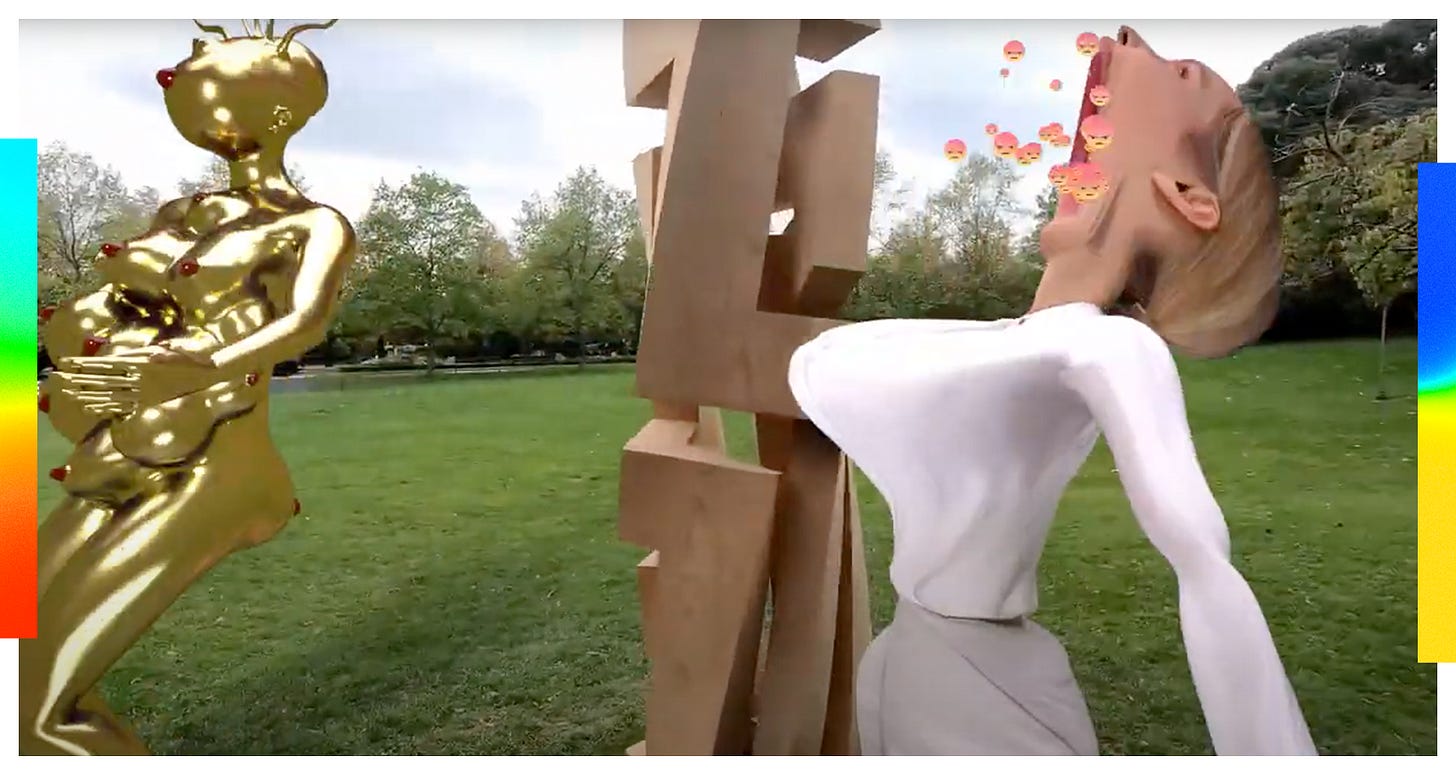Instagram Is Visually Training Everyone, with Marjan Moghaddam
On the eve of her latest tokenized digital art auction, Rumfoords sat down with Marjan Moghaddam to talk patronage, utopia, imagination and metrics versus quality.
Rumfoords knows the best when we see it.
The immediate future is right in front of us, although, like past frontiers, it’s filled with jargon like “NFT” and “crypto” and “blockchain.”
Marjan Moghaddam is, once again, the best and most visionary artist to guide our way through it.
The Instagram page maintained by Moghaddam, whose 2018 animation “Baisser,” below, went viral across multiple platforms and was selected by Nowness as a culturally significant work, proves she’s a pioneer of the virtual and digital art world. Starting with .gifs and then riding a wave of social media virality, her next frontier is one-of-a-kind digital collectible art known as crypto art, seen by many as the future of art and fashion.
On Valentine’s Day, Moghaddam will auction off a new original animation that is a spin on her iconic “Baisser,” with a new backdrop modeled after the original Mary Boone with GAN collaged paintings on the wall and new music by Blake Skipper.
Moghaddam calls these works #ArtHacks. Rumfoords sat down with Moghaddam to ask her about the voluptuous and psychedelic figures that seem to spring out of the imagination of a hallucinating fashion designer to haunt gallery spaces in her work. But that led to a wide-ranging conversation on our collective imaginations, patronage, and expression in crypto art. Enjoy!
Rumfoords: You once said something that struck me as particularly relevant to what we’re doing at Rumfoords: “Fashion is exploring additional variations of the body and gender.” How much do you think the art world can learn from fashion right now?
Marjan Moghaddam: I said that in reference to my “Glitch Goddess” work. It’s an interesting synergy between the two. If you look at most Western art history you will see that the synergy between the two worlds exists. If you look at examples of work from the Baroque, even the Renaissance, whether it’s Italian or Netherlandish, or even 19th century paintings from Europe, you’ll see that the latest couture fashions were part of the aesthetic dialogue of those paintings. So the relationship has always been there. And the same also, I should add, exists in Asian art, because I come from Iran. So this is not, in my opinion, a contemporary relationship or a synergy because it’s an art historic one. It’s also not just Western, you’ll see it in Persian miniatures, Indian miniatures, and Chinese scrolls and Japanese, so it’s a global phenomenon.
R: Do you look to fashion for inspiration?
MM: I don’t look at fashion as necessarily, “Oh, this is something I want to wear.” I look at fashion purely as aesthetic, so I see volume, I see form, I see composition and I see color. And one of the things that I actually do appreciate about fashion is that there is a certain degree of refinement and articulation in terms of aesthetics that I think most artists who are visually oriented really appreciate. The forms themselves to me are sometimes exquisite sculptural forms and the color and the composition, too.
R: You once said that “Instagram has now made art a part of most people’s daily life on mobile.” How does it feel to be at the vanguard of an entirely new ecosystem for art?
MM: On some levels I’ve been at the vanguard for some time. In 1996 my domain, marjan.com, went down because I had so many hits on the early internet from the early gif animations I was doing. So I feel like I’ve had these waves with each iteration of the internet since.
Instagram, for me, was a recent iteration. And crypto art is the latest. I’m always interested in innovation. The aspect of Instagram that I think is really important is that it’s almost visually training everyone. Because when I look at some of the works, not everything that becomes popular on Instagram is that noteworthy, in my opinion. This isn’t to suggest that metrics automatically equal quality, but what is emerging in our world is that increasingly metrics can also mean quality. Because I think in the earlier iterations of the internet metrics were almost always some type of a spectacle or something designed to work with basic human instincts and something involving spectacle or gross things, something that has this visceral effect. And now, the internet is maturing. So you’re actually seeing things that get eyeballs, that get the metrics, that are pretty substantial.
R: You’ve written that you “explore what I consider as our ‘collective and aggregated technologically enhanced imagination,’ on the net.” When did you realize that our imaginations were technologically enhanced?
MM: I think that became evident to me with my first computer graphics classes in college in the early 1980s, because I saw the potential. I had to take classes in traditional cel animation and I took classes in early computer graphics and animation, so I immediately understood that with this the sky’s the limit.
But I think that in the last ten years it’s become pretty evident to me, and this is something that many digeratis have brought up. We're making a transition from a knowledge-based economy to an imagination economy. The 21st century economies, for developed nations, will be imagination economies. The metaverse, VR, AR, XR, these are the 21st century imagination economy technologies. And on some levels, when you think about it, cryptoart is the perfect iteration of the imagination economy, because these are non-fungible art pieces, they don’t exist in the physical world, their entire creation and existence and, on some levels, their valuation and estimation is imaginary. So we really have entered the imagination economy whether we realize it or not.
But then if you look at the political events in the United States, but also Europe, if you look at QAnon and conspiracy theories, InfoWars and the propagandization of everything, you realize there’s a downside to this imagination economy, as well. It’s not all groovy VR and XR, it’s also a coup attempt on the capitol and riots that burn down an entire American city.
R: So do you think that there are versions of the imagination economy that can be utopian?
MM: Well, the human imagination is a place of great hope and great despair and good and evil, that’s the problem. Utopianism itself is rooted in the imagination, there is no such thing as a utopia without a human imagination. But the same applies to a dystopia. My concern is that we don’t know how to handle it, we don’t have the critical and analytical understanding and regulations that this iteration of technology requires yet. And so it’s a little bit of a Wild West. And it’s bringing out a lot of the scary stuff.
R: Do you think cryptoart can be, if not a force for good in the future, at least a positive force?
MM: The potential exists. Every major era in art history had some type of a patronage system that allowed it to bring the higher ideas to the culture. And, increasingly, crypto art evangelists write articles and post things on Twitter arguing that this is another Renaissance. But I think that they’re using the term Renaissance as a figure of speech as opposed to the actual art historic term. Because if the Italian Renaissance was about mere visual spectacle and entertainment of the masses then it would be the Rococo, which was another era in art history when you had lots of people who had just come into money and were buying art for the first time and were employing many artists who were producing works that were ornate and had filigrees and flourishes but didn’t really have the substance of the Renaissance. The Renaissance was, first and foremost, a philosophical shift and then a scientific, cultural and artistic shift. Artists of the Renaissance like Michelangelo and Da Vinci were more knowledgeable about Greek philosophy than the top scholars in Florence, so these weren’t artists who just relied on visual spectacle. If anything they restrained visual spectacle in their works.
Crypto art right now is all about eyeballs, and the Renaissance was about restraint of the visuals in order to convey higher ideas. That’s why the posing is very mannerist and restrained. That’s why the colors had to be very balanced. They had very strict rules about that sort of thing, based on philosophical ideals.
You know, radio was one of the most important technological innovations of the 20th century. And I’m sure earlier there were great works of art in radio but we don’t look at the art that came out of the technology of radio as the greatest art of the 20th century, do we? No, not really. So you have to be careful with art that comes out of these technological iterations because it might not be the highest expression of the culture.
R: In fact, the one piece of art that I think when I think of the best radio art is pure spectacle, and that was “The War of the Worlds.”
MM: But that was based on a literary work.
R: Even better. Do you see crypto art going in a direction where some quality might surface?
MM: Not until the collectors start collecting that work. The most recent big buzz in the crypto art world was the Beeple collection. The question we need to ask is, “Does Beeple and his CG work represent the highest expression of our culture?” If the answer to that question is no, despite my respect for Beeple’s work, then you realize that the patronage system that should be bringing in the greater cultural works is not yet in existence in the crypto space.
R: Do you hope that it emerges there?
MM: Well, yes. Let me clarify a few things, and this is very important. I believe everything is art. A little child painting their plate with mustard and ketchup is art as far as I’m concerned. So to me art is not necessarily a painting in the museum. In addition to creating and exhibiting fine arts for decades I was also production artist working at animation companies on commercial CG projects for many years. And consider the applied arts also as art, so there’s no way that I’m going to say that art is only a painting at MoMA. But I do believe that not all forms of art are bringing or aiming to create works to convey the greatest sublime ideas in the best way possible.
So for me, there are a lot of works that get eyeballs, fit perfectly into the attention economy, and serve that function very well, but are not necessarily expressing higher ideas of the sublime. So when you think of the most memorable works of art from your life, there will be at least one or two pieces that were aiming for and delivered the highest expressions of the sublime. So the question is, “Can crypto art embrace that?” Because I think a lot of the work that is performing extremely well right now may not necessarily be the most sublime expressions of art. And I think it’s pretty evident to everybody, and I’m not saying that to be insulting or anything of that kind. I respect this work, it inspires me, I love a lot of it. But I think that when you’re dealing with different types of art, distinction matters. And distinctions have to be made.







